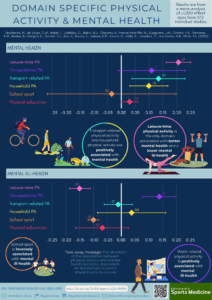Why is the study important?
Physical activity is well known for supporting mental health, but it’s often assumed that any movement is good. Research shows that lots of different types of physical activity – walking, running, yoga, resistance training – can help, but in reality, not all activity does. Physical activity is more than just a number of steps, or a certain amount of effort exerted. It’s a complex behaviour shaped by what we do, where we do it, who we do it with, and when we do it.
One way to understand this is by looking at the area(s) of life in which activity occurs – these are called ‘domains’. Domains include leisure-time (our own free time where we have some choice over how we spend it), work or school, transport (walking or cycling to get from place to place), or household activities such as cleaning, gardening, or caring for others. While lots of people intentionally exercise in their free time, others get their activity through jobs, chores, or commuting. This raises an important question: is physical activity in any domain good for mental health?
How did the study go about this?
The authors identified all existing studies that have ever looked at links between physical activity and mental health across different life domains. They grouped the studies by domain and combined all of the studies to see the overall effect for each domain.
Here’s how to interpret the findings you’ll see in the infographic
Mental health (the top figure) refers to all positive aspects of mental health like wellbeing and life satisfaction. The bottom figure includes all negative aspects like stress, depression, and anxiety. A higher number next to the diamond means a stronger connection (or association) between physical activity and mental health. A shorter line means the findings are more consistent.
What did the study find?
Leisure-time physical activity has the strongest link with mental health – in fact, it is the only domain where physical activity is linked to both better mental health AND reduced mental ill-health, with evidence consistent across hundreds of studies. 
Transport (like cycling to work) and household-related activity are connected with better mental health, but not with lower mental ill-health. Although the evidence is less consistent compared to leisure-time. is less consistent. Activities like gardening or cycling to work may lift mood but not necessarily provide the same protection against negative symptoms.
Physical activity during work tells a different story – it’s linked to greater symptoms of mental ill-health. This doesn’t mean physical activity during work is necessarily harmful, but it shows that not all movement has guaranteed benefits for mental health.
Except for one link with lower mental ill-health, for school sport and PE, most associations are inconsistent and there are far less studies.
What are the key take-home points?
- Not all physical activity is equal.
- Physical activity that you choose to do during your own free time is most likely to reduce symptoms of mental ill-health and improve mental health.
What should you do with this information?
- Prioritise physical activity you actually want to do whatever that looks like, whether that’s dancing, hiking, swimming, or playing tennis.
- Don’t rely on work activity or household chores alone to support your mental wellbeing – make time for movement you enjoy.
Read the full paper here!